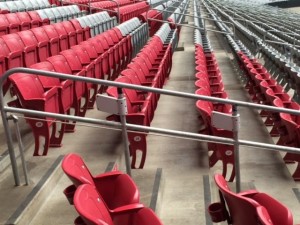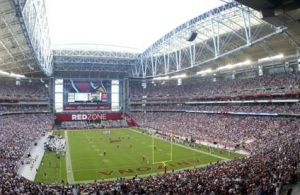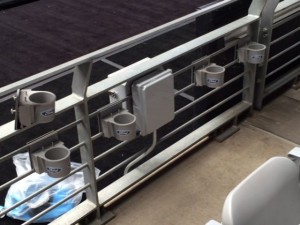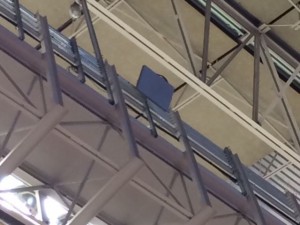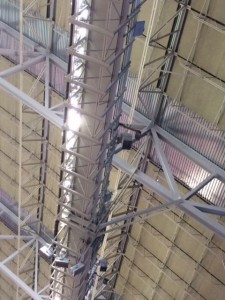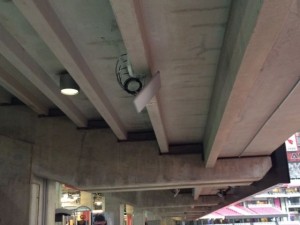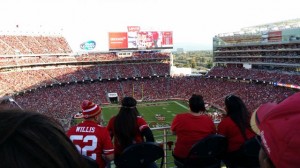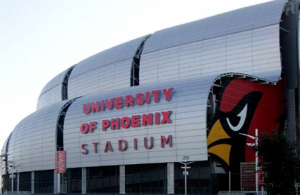
University of Phoenix Stadium. Credit all photos: Arizona Cardinals. (click on photos for larger image)
“It’s funny to look back now on that first Super Bowl,” said Mark Feller, vice president of information technology for the Arizona Cardinals, speaking of Roman numeral game XLII, held in the barely 2-year-old facility on Feb. 3, 2008. With a couple Fiesta Bowls and one BCS championship game (2007) under his belt in a facility that opened with Wi-Fi and DAS, Feller said he and his team “thought we had a good handle” on what kind of network was required for a Super Bowl crowd.
The NFL, he said, begged to differ. Those college games might have been big, but the Super Bowl was bigger.
“We had the Fiesta Bowl that year at night, and when the game was over there were people from the NFL there wanting to know when they could set up,” said Feller in a recent phone interview. “This year, we’re much better prepared. We know what the water temperature is this time.”
Rip and replace, with more and better gear
For Super Bowl XLIX, scheduled to take place in Glendale on Feb. 1, 2015, Feller and his team have not just tuned up their network — they have done a full rip and replace of the Wi-Fi system, installing new Cisco gear from back end to front, in order to support a wireless game-day demand that is historically second to none. Integrator CDW has led the Wi-Fi effort and Daktronics and ProSound did the installation of new video screens, and neutral host Crown Castle has overseen a revamp of the DAS system, again with more antennas added to bolster coverage. In all, there has been more than $8 million in wireless improvements before this year, Feller said, as well as another $10 million for two new video boards that are each three times larger than what was there before.“The last three or four years there have been things we knew we needed to improve [before the Super Bowl],” Feller said. After extensive work with the NFL’s technical team — this time well before the Fiesta Bowl — Feller oversaw a “top to bottom” refurbishment that included replacing core Cisco networking gear with newer gear, and new and more Wi-Fi access points that now total somewhere north of the 750 mark, with some more to be added before the big game. The new network, which was in place for the start of the current NFL season, has undergone testing by CDW at each home game, Feller said. CDW also plans to expand the network outside the stadium before the Super Bowl, in part to handle the extra events that take place not just on game day but in the days leading up to the game.
“The plan is to install more [coverage] outside, in the plaza areas,” Feller said.
When it opened in 2006, the $455 million University of Phoenix Stadium was one of the first with full-bowl Wi-Fi, using Cisco gear from the inside out. “Cisco was in here before they called it [their solution] ‘connected stadium’,” Feller said. From core network switches to firewalls to edge switches, this year there is all new Cisco gear in the venue, as well as new 3700 series APs, with panel antennas and antennas in handrails.
“Handrail [antennas] are sometimes a bit of a challenge, because you need to drill through concrete that’s 40 feet up in the air, behind another ceiling,” said Feller, describing one particular design challenge. Another one was mounting antennas on drop rods from the catwalks below the stadium’s retractable roof, to serve the upper-area seating. There are also some new Wi-Fi APs on the front row of the seating bowl, pointing up into the crowd.
“It was a fun project,” Feller said.
All on board for the DAS
The upgrade for the stadium’s DAS, led by Crown Castle, was just finished a few weeks ago, Feller said, and included more coverage outside the stadium as well, with antennas placed on light poles and on the stadium’s shell.
“Crown Castle did a great job of managing the carriers” on what is a 48-sector DAS, Feller said. “It [the upgrade] really required a lot of creative thinking from their engineers.”
Since the stadium was originally designed with wireless in mind, Feller and his team didn’t need to build new head end room for the DAS upgrades. “But I wouldn’t say we have plenty of space left,” he added. “We’ve got a lot of new equipment.”
Though all the major carriers are expected to be on the DAS by the big game, league partner Verizon Wireless should have some special projects up its sleeve for the big game, including another demonstration of its LTE Broadcast technology, which optimizes things like live video over LTE cellular links.
New Cardinals app a preview of Super Bowl version?
The Cardinals also had a new version of the game-day team app for this season, built by stadium-app leader YinzCam. According to Feller the new app supports three different live video feeds, as well as instant replays.
“It’s really cool to have that ability to watch things like a touchdown pass at the end of the game,” Feller said. And while no details have yet been revealed, in an interview with NFL CIO Michelle McKenna-Doyle earlier this year MSR learned that the league and YinzCam are working on a Super Bowl app with its own new bells and whistles. (Stay tuned for more info on the Super Bowl app.)In addition to two more regular-season home games in December, the University of Phoenix Stadium will have at least a couple more dry runs to help test the network, during the Dec. 31 Fiesta Bowl and during the NFL’s Pro Bowl, scheduled for Jan. 25. And though the Cardnials lost to the Atlanta Falcons Sunday, at 9-3 they are still tied with the Green Bay Packers for the best record in the NFC, something that has the Phoenix faithful optimistic about the postseason.
“We’re going to get some more test runs, on New Year’s Eve and during the Pro Bowl,” Feller said. “And maybe some home playoff games as well!”
(more photos below)
